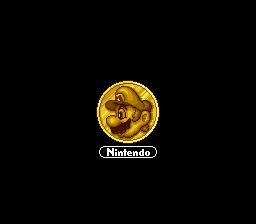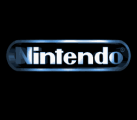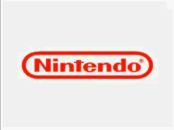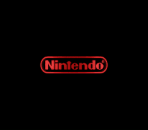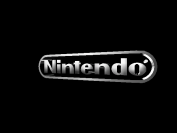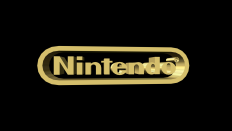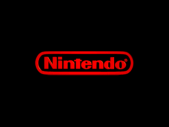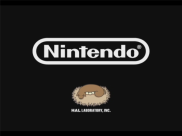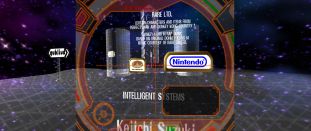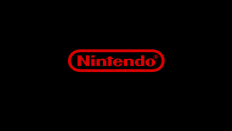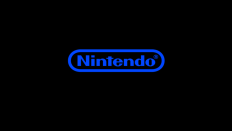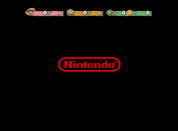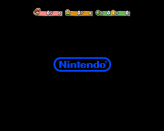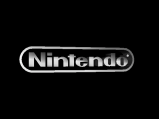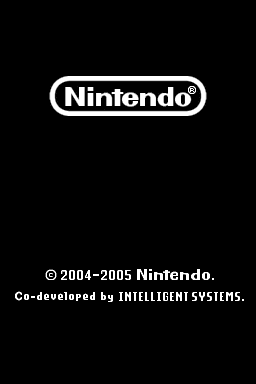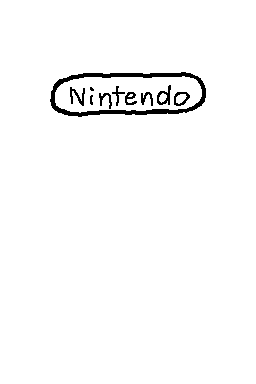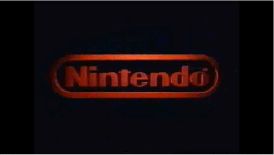Nintendo
Jump to navigation
Jump to search
Nintendo
1st Logo
(1986- )
Logo: Not really a logo, but on a background is the words Licensed by Nintendo.
Variant: On some games, Licensed by Nintendo of America, Inc. appears instead of Licensed by Nintendo.
FX/SFX: None.
Music/Sounds: None.
Availability: Very common. Seen on Nintendo-licensed games since 1986.
Editor's Note: None.
2nd Logo
(November 21, 1990-October 21, 2003)
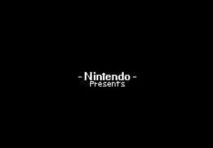 <embed allowfullscreen="true" height="149" src="http://wikifoundrytools.com/wiki/closinglogos/widget/youtubevideo/e6da1fac2ad48d834fc14cfedae3ba59289fadb9" type="application/x-shockwave-flash" width="179" wmode="transparent"/>
<embed allowfullscreen="true" height="149" src="http://wikifoundrytools.com/wiki/closinglogos/widget/youtubevideo/e6da1fac2ad48d834fc14cfedae3ba59289fadb9" type="application/x-shockwave-flash" width="179" wmode="transparent"/>
Nickname: Nintendo Presents....
Logo: On a black background, we see - Nintendo - in its corporate font without the round shape. Below it is Presents".
FX/SFX: None.
Music/Sounds: A random sound effect from a game.
Availability: Uncommon. Seen on Super Mario World, Super Mario World 2: Yoshi's Island, The Legend of Zelda: A Link To The Past, Super Scope 6 and the Super Mario Advance games except for the first one.
Editor's Note: None. This one's tame, compared to the next logo...
3rd Logo
(1990)
Nicknames: The Gold Mario Coin, Nintendo Coin
Logo: On a black background, we see the normal Nintendo logo but the round shape is stretched out a bit. On top the text is a gold Mario coin, that shines once.
Variant: On Super Mario Kart, Yoshi's Safari, Super Punch-Out!! (this game has the logo in silver), and Stunt Race FX (this game has the logo in pink), there's no gold Mario coin.
FX/SFX: The coin shining.
Music/Sounds: The coin sound effect from the 2nd logo. On Stunt Race FX, a honking sound effect is heard. On Super Punch-Out!!, TBA.
Availability: Uncommon. Seen on Super Mario Kart, Super Mario All-Stars (+ Super Mario World), Stunt Race FX, Super Punch-Out!!, Yoshi's Safari, and Super Mario All-Stars 25th Anniversary Edition.
Editor's Note: None; much tamer than the previous logo.
5th Logo
(1993- )
FX/SFX: A usual effect or none.
Music/Sounds: A sound from the game or silence. On the Mario Kart 64 variant, the sounds of cars driving by. On the Goldeneye 007 variant, the opening theme plays. On Perfect Dark, the droning sound is heard as it continues from Rare logo. On Animal Crossing: Wild World, a child says "Nintendo". The Donkey Kong 64 variant has Donkey Kong saying "Okay". On Luigi's Mansion it has a very deep voice saying "Nintendo". On Killer Instinct, a dark-sounding theme plays.
Availability: Very common. Can be seen on most Nintendo games such as Mario Kart 64.
Editor's Note: None.
6th Logo
(June 24, 2002)
Nicknames: "Eternal Darkness", "Nintendo's Dark Side", "Creepy Nintendo", "Sintendo"
Logo: On a black background, we see some reddish-grey smoke rising, forming a red skeleton with its eyes lit green which then looks to the camera with its mouth opening. Its eyes brighten up before a cyan flash of light appears, causing the skeleton to move to the right, off the screen. The flash becomes a beam of light, circling around before it reaches the bottom-center of an outline of the Nintendo logo. It flashes even brighter and the full Nintendo logo appears in light blue. Throughout its screen time, the color of the Nintendo logo changes to red.
FX/SFX: All CGI.
FX/SFX: The logo zooming and spinning and the shining wipe effect.
Music/Sounds: Silent for Pokemon: The First Movie and Doubutsu No Mori (the Japanese name for the Animal Crossing series, which translates to Animal Forest), but the other movies had a shining sound.
Availability: Rare. Seen on Pokemon: The First Movie, Pokemon The Movie: 2000, and Pokemon The Movie 3, which were released by Warner Bros. in the United States.Also seen on Doubutsu No Mori (Animal Crossing), released in 2006 in Japan only.
Editor's Note: Minimal.
Editions by TheLogoChamp, mariolover, Muzzarino, Mr.Logo, McDonald's1, and GETENTLogo captures by Mariocenter, Muzzarino and Mandog20000
Background: Nintendo is a consumer electronics company centered around the development of video games, and hardware to run them. The company was founded in 1889 by entrepreneur Fusajiro Yamauchi, originally as a seller of card games, at the time banned by the Japanese government due to its ties to gambling; Yamauchi's playing cards were one of few that were permitted for sale to the Japanese public. Around the 1960s, Nintendo started to experiment with numerous ventures, including a taxi service (their most successful venture at the time), love hotels, a TV network, and the sale of instant rice. After securing the rights to distribute the Magnavox Odyssey game console in Japan in 1974, Nintendo started to solely focus on the development of video games and gaming hardware for both arcades and home use. Today, Nintendo is best known for their participation in the video game console market, with consoles such as the DS, Game Boy, Wii, NES, and, most recently, Switch. They are also the owners of numerous iconic gaming franchises, including Mario, Donkey Kong, Pokemon, Metroid, and Zelda.
Nintendo started using stylized logos in their games in 1990.
Nintendo
1st Logo
(1986- )
Logo: Not really a logo, but on a background is the words Licensed by Nintendo.
Variant: On some games, Licensed by Nintendo of America, Inc. appears instead of Licensed by Nintendo.
FX/SFX: None.
Music/Sounds: None.
Availability: Very common. Seen on Nintendo-licensed games since 1986.
Editor's Note: None.
2nd Logo
(November 21, 1990-October 21, 2003)
 <embed allowfullscreen="true" height="149" src="http://wikifoundrytools.com/wiki/closinglogos/widget/youtubevideo/e6da1fac2ad48d834fc14cfedae3ba59289fadb9" type="application/x-shockwave-flash" width="179" wmode="transparent"/>
<embed allowfullscreen="true" height="149" src="http://wikifoundrytools.com/wiki/closinglogos/widget/youtubevideo/e6da1fac2ad48d834fc14cfedae3ba59289fadb9" type="application/x-shockwave-flash" width="179" wmode="transparent"/>Nickname: Nintendo Presents....
Logo: On a black background, we see - Nintendo - in its corporate font without the round shape. Below it is Presents".
FX/SFX: None.
Music/Sounds: A random sound effect from a game.
- On Super Mario World and Yoshi's Island for SNES, a coin sound effect is heard.
- On Yoshi's Island: Super Mario Advance 3, Yoshi says the word "Nintendo".
- On The Legend of Zelda: A Link To The Past, a rupee sound is heard.
- There is no sound on Super Scope 6.
Availability: Uncommon. Seen on Super Mario World, Super Mario World 2: Yoshi's Island, The Legend of Zelda: A Link To The Past, Super Scope 6 and the Super Mario Advance games except for the first one.
Editor's Note: None. This one's tame, compared to the next logo...
3rd Logo
(1990)
<embed align="right" allowfullscreen="true" height="167" src="http://wikifoundrytools.com/wiki/closinglogos/widget/youtubevideo/662bbe72d839e039d5117277a75e606dc10aae68" type="application/x-shockwave-flash" width="203" wmode="transparent"/>Warning: Do not watch the video if you're prone to epilepsy. Also, it's very loud, so lower the volume before watching it.
Logo: Same as the Nexoft logo used in Penguin Wars, but with the corporate Nintendo logo, but without the oblong shape.
FX/SFX: See Nexoft.
Music/Sounds: See Nexoft.
Availability:Ultra Rare. Seen only on King of the Zoo, a European localization of Penguin Wars, for the Game Boy.
Editor's Note: See Nexoft.
4th Logo
(September 1, 1992-December 1994, December 12, 2010) (USA)
FX/SFX: See Nexoft.
Music/Sounds: See Nexoft.
Availability:Ultra Rare. Seen only on King of the Zoo, a European localization of Penguin Wars, for the Game Boy.
Editor's Note: See Nexoft.
4th Logo
(September 1, 1992-December 1994, December 12, 2010) (USA)
Nicknames: The Gold Mario Coin, Nintendo Coin
Logo: On a black background, we see the normal Nintendo logo but the round shape is stretched out a bit. On top the text is a gold Mario coin, that shines once.
Variant: On Super Mario Kart, Yoshi's Safari, Super Punch-Out!! (this game has the logo in silver), and Stunt Race FX (this game has the logo in pink), there's no gold Mario coin.
FX/SFX: The coin shining.
Music/Sounds: The coin sound effect from the 2nd logo. On Stunt Race FX, a honking sound effect is heard. On Super Punch-Out!!, TBA.
Availability: Uncommon. Seen on Super Mario Kart, Super Mario All-Stars (+ Super Mario World), Stunt Race FX, Super Punch-Out!!, Yoshi's Safari, and Super Mario All-Stars 25th Anniversary Edition.
Editor's Note: None; much tamer than the previous logo.
5th Logo
(1993- )
- Killer Instinct: Asilvery-blueNintendo logo zooms out and glows red. It then turns right and goes to the top-right.
- Mario Kart 64: We start off with a side view of the Nintendo logo. The logo is gold. Suddenly, it starts spinning around, getting faster and faster. As it does this, a trail of pieces of the logo shows up, and the logo remains this way as it fades to white.
- Goldeneye 007: The Nintendo logo, in silver, zooms in suddenly and spins around at a slow and steady pace.
- Perfect Dark: The silver Nintendo logo tilted downwards in the darkness appears and faces the viewer while the light brightens up to make the logo visible as it slowly turns and becomes dark again.
- On most Nintendo games: The Nintendo logo is red and is on a black or white background. For Japanese releases, the logo is blue. Starting in 2006, the logo is now grey.
- Super Smash Bros Melee: The Nintendo logo is white on the FMV intro. In the credits, the logo shown on the sign is colored blue.
- Donkey Kong 64: Same as the previous variant, except it suddenly appears. On the Japanese release of the game, the Nintendo logo is silver instead of red.
- WarioWare: Touched!: We see a stylus drawing the word "Nintendo" after that, it draws an round shape like in the previous logo, and then the logo cuts to black as the corporate logo in white fades in, the bottom screen has a copyright notice (US and Europe versions has the years in use 2004-2005 while the Japanese version was released in 2004).
- WarioWare: Twisted!: We see the corporate Nintendo logo in red (the Japanese version has the logo in black) spinning and stopping in the corner on a yellow background, and then fades into a scene of the game.
- Paper Mario: The Thousand-Year Door: The logo has is red on a black background, but the game has a HUD that appears at the top of the logo where it cannot be seen. When the field of view linked within the HUD size starts in a wide angle using one of these Action Replay codes below, the game's HUD can be seen.
- NTSC-U:
[[1]] 3f200000
PAL:
04435E80 3f200000
NTSC-J:
04422dd0 3f200000 - Most other games have the logo still, along with being silent.
- Rhythm Tengoku (Arcade Version): The Nintendo logo is blue on a white background.
FX/SFX: A usual effect or none.
Music/Sounds: A sound from the game or silence. On the Mario Kart 64 variant, the sounds of cars driving by. On the Goldeneye 007 variant, the opening theme plays. On Perfect Dark, the droning sound is heard as it continues from Rare logo. On Animal Crossing: Wild World, a child says "Nintendo". The Donkey Kong 64 variant has Donkey Kong saying "Okay". On Luigi's Mansion it has a very deep voice saying "Nintendo". On Killer Instinct, a dark-sounding theme plays.
Availability: Very common. Can be seen on most Nintendo games such as Mario Kart 64.
Editor's Note: None.
6th Logo
(June 24, 2002)
<iframe frameborder="0" height="207" src="http://wikifoundrytools.com/wiki/closinglogos/widget/unknown/6dcc8b002ff0fbc27c1fc33701169f99a019445c" width="366"></iframe>
Nicknames: "Eternal Darkness", "Nintendo's Dark Side", "Creepy Nintendo", "Sintendo"
Logo: On a black background, we see some reddish-grey smoke rising, forming a red skeleton with its eyes lit green which then looks to the camera with its mouth opening. Its eyes brighten up before a cyan flash of light appears, causing the skeleton to move to the right, off the screen. The flash becomes a beam of light, circling around before it reaches the bottom-center of an outline of the Nintendo logo. It flashes even brighter and the full Nintendo logo appears in light blue. Throughout its screen time, the color of the Nintendo logo changes to red.
FX/SFX: All CGI.
Variant: On the PAL/European version of the game, the Nintendo logo would turn blue instead of red.
Music/Sounds: Ominous orchestral music, accompanied by the skeleton growling. After the Nintendo logo gets formed, a creepy male announcer says the company name.
Availability: Only appeared on Eternal Darkness: Sanity's Requiem for the Nintendo GameCube.
Editor's Note: The smoke, the frightening and jarring appearance of the creature growling, the orchestral sting and the creepy announcer will be very unsettling to most. But this is obviously intentional given the subject matter of the game that follows it.
___________________________________________________________________________________
Nintendo Films
(November 6, 1999-March 29, 2001, December 16, 2006) (USA)
Music/Sounds: Ominous orchestral music, accompanied by the skeleton growling. After the Nintendo logo gets formed, a creepy male announcer says the company name.
Availability: Only appeared on Eternal Darkness: Sanity's Requiem for the Nintendo GameCube.
Editor's Note: The smoke, the frightening and jarring appearance of the creature growling, the orchestral sting and the creepy announcer will be very unsettling to most. But this is obviously intentional given the subject matter of the game that follows it.
___________________________________________________________________________________
Nintendo Films
(November 6, 1999-March 29, 2001, December 16, 2006) (USA)
Nicknames: "Shining Nintendo", "Nintendo!"
Logo: On a black background, we see a 3D Nintendo logo zoom in and rotate to face us. As it is rotating, a shining effect wipes across the logo.
Logo: On a black background, we see a 3D Nintendo logo zoom in and rotate to face us. As it is rotating, a shining effect wipes across the logo.
Variant: On the trailer for Pokemon The Movie: 2000, it is on a space background and 2D.
FX/SFX: The logo zooming and spinning and the shining wipe effect.
Music/Sounds: Silent for Pokemon: The First Movie and Doubutsu No Mori (the Japanese name for the Animal Crossing series, which translates to Animal Forest), but the other movies had a shining sound.
Availability: Rare. Seen on Pokemon: The First Movie, Pokemon The Movie: 2000, and Pokemon The Movie 3, which were released by Warner Bros. in the United States.Also seen on Doubutsu No Mori (Animal Crossing), released in 2006 in Japan only.
Editor's Note: Minimal.
